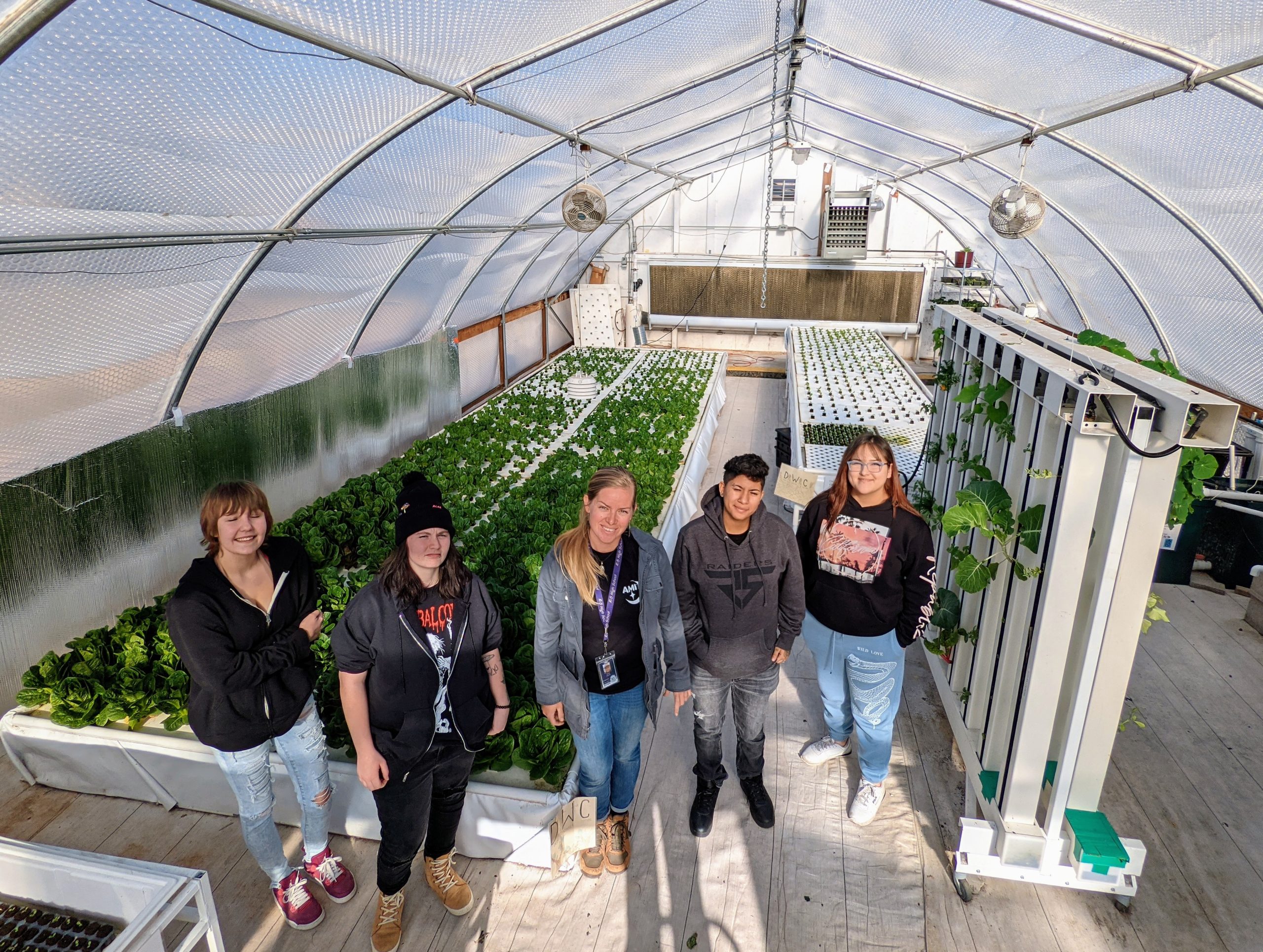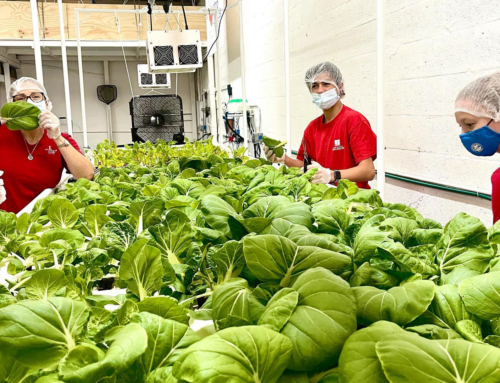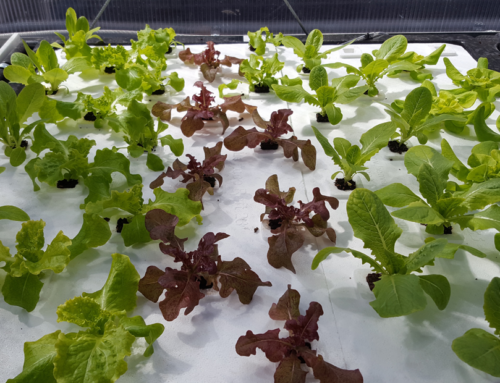R5 High School: Students as Farmers as Teachers
Maddy may be surface level bashful, but her unearthed dedication to her school’s aquaponics speaks for itself.
And if she won’t say it, faculty and staff at R5 High School will. When asked who the ‘go-to’ is in the greenhouse, they share one resounding word: Maddy. But she’s not alone. The word ‘team’ was used often by students Maddy, Skyler, and Ineke as they sat in beside R5 science teacher and staff member Dustin Giesenhagen and Sherah DaCosta to discuss how aquaponics is contributing to their sense of belonging and overall education.
R5 High School in Grand Junction, CO is a model of possibility. It’s framework where potential flourishes within expressive niches. A forward thinking response to the short comings of stunted exclusory high school cliques. The type of learning development traditionally re-imagined only in hindsight by those who graduated from the system and look back on it and wonder how it could have been different. But that’s R5: Different normalized by Foresight.
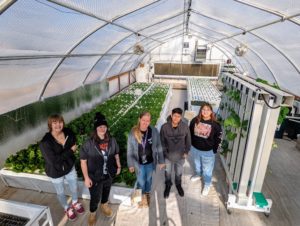
R5’s learners backdropped by their successful aquaponics Flourish Farm System.
Hearing R5’s students talk about their fondness for their school makes any listener envious. Envious, but grateful. Grateful that something’s being done. And for those who press their ear to listen to the aches and pains of society, rest assured R5’s students are at the forefront expertly using agriculture to suture the wounds. Just as their mission-centric curriculum is compassion-driven and niche, so too is their gardening.
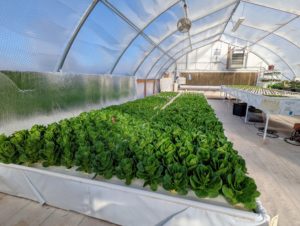
This deep water culture trough looks ready for harvest.
Inside R5’s greenhouse is a Flourish Farm designed in 2018 by The Aquaponic Source, a five-media bed, dual deep water culture troughed aquaponic system with the production capacity of 250 fish annually, 450lbs of tomatoes seasonally, and 200 leafy greens weekly. And although not completely un-chaperoned(Sherah spends about four hours a day co-managing the greenhouse), the students are as qualified and responsible for the daily operations as the best of them. To date, the cohort in question is made up of a little more than a dozen students who fully embrace their amateurish distinction.
Water quality testing. Fish feeding. Seeding. Transplanting. Rotating. Harvesting. Trouble shooting. Any task performed by a commercial-sized aquaponic farm manager is performed to scale by these collaborating students.
Which brings us back to the Maddys of the world. The proofs that as the world gets older, its pioneers get younger. Take for example, the inherent difficulty of preventing iron deficiencies in plants, a problem many aren’t made aware of until their green leaves yellow. Maddy brought the idea of creating a mathematical formula to detect and prevent early iron deficiency to her math teachers. Now, consequentially, non-agricultural teachers find themselves concerned with an aquaponics system and are completing homework assigned by a student. Its a numbers-driven experiment that when solved will signal a green light for more student-led management. Although, even without the completion of her formula, the school is putting together a novel internship opportunity that will give Maddy an official position to autonomously operate the aquaponics system over the summer. She’ll even get a key to the greenhouse.
R5’s aquaponic system manifests social engagement. Let’s start at the lower level. R5 has buddied with a local elementary school to coach the future could-be farmers through an aquaponics system. And who are the teachers? The students. They give tours. They ask questions, answer others. It’s akin to when 8th graders read to 1st graders during Friday’s free period, only this time, the words are edible.
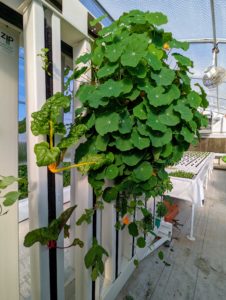 For higher levels, R5 has also teamed with their local Colorado University campus to provide aquaponically grown produce to its culinary department. In exchange? The cooking lab is made available to R5’s aquaponic students to learn how to chef.
For higher levels, R5 has also teamed with their local Colorado University campus to provide aquaponically grown produce to its culinary department. In exchange? The cooking lab is made available to R5’s aquaponic students to learn how to chef.
What about community outreach? Well, for one, the greenhouse is free as a ‘U-pick’ style farm where any student, faculty, or staff can access the harvest. This highlights one of aquaponics greatest advantages: speedy turnover rates. Crucial and viable in an institution prone to semester breaks and fire drills. Here, students are afforded the unique feature to pick ingredients to take home and throw in with family diners. As of this writing, no parents have complained.
If mentoring elementary students and cooking in universities weren’t incentives enough, once a month a local family-owned Mexican restaurant uses donated produce from the school’s aquaponic system to whip up a free meal for the whole school. We call that entrepreneurship.
It’s hard to discern when speaking to the students just what the real advantages of operating an aquaponic system are. Ineke said her initial attraction to aquaponics was the availability of herbs. But now she’s vermicomposting. Skylar loved the aroma in the greenhouse. Now she’s into operational mechanics. Maddy keeps to herself. Now she’s providing for others.
Maybe without realizing it, or maybe with realizing it, with their aquaponics system, the students at R5 High School are taking part in an education revolution. One where learning is visible, tangible, chewable. Where a student’s contributions and minor adjustments are readily detectable. Where a tender exchange takes place between students and community, with one side providing the food and the other side the meal. Where a challenge to the norm means a chance to grow.
It’s impossible to distinguish between the R5 students and the community just who the benefactor is and who is the beneficiary. Maybe it doesn’t matter. Maybe all that matters is, as Skylar puts it, “There’s something going on here.”

